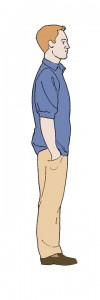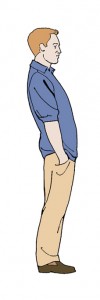
 Everyone I look at whether at work or on the street, seems to be leaning backward when they stand and walk.
Everyone I look at whether at work or on the street, seems to be leaning backward when they stand and walk.
If someone leans back all the time they are going to have tight lower back muscles.
If the shoulders are behind the hips when standing the lower back muscles are going to be shorter and the abdominal muscles at the front of the body are going to be longer. This imbalanced muscular relationship is at the heart of much of our back pain.
Habitual leaning backward stems mainly from the fact that so many people tend to tuck their pelvis under a lot of the time.
The top of the pelvis is meant to be level with the earth when we are upright—this allows for the legs and the trunk to line up with each other above and below the pelvis.
This is important for many reasons. Transferring weight successfully through the bones and allowing space for our nerves to travel freely towards their destination are just two of them.
If you have tight lower back muscles you need to exercise to stretch and lengthen them.
You also have to change your posture if you want to keep them lengthened. You can do all of the exercises that I love for working the lower back to no avail if you don’t change the way you stand and walk.
The Way We Habitually Walk Stand and Sit Leads To Tight Lower Back Muscles
We walk, stand and sit way more than we exercise. There is no way around that.
This means that standing is going to have more influence on the tone of your muscles than exercising.
You need to stretch your muscles etc, but if you don’t use them correctly when walking, standing, or sitting they will never change permanently.
At the beginning of every yoga class or walking lesson that I teach, I ask people to stand up straight – which means they lean backward while thinking that they’re straight—and then I walk around and put them upright (or at least my image of upright).
Once I put them in this new position it is only a matter of time before they will be pulled backward again.
This often happens to the first student in a class that I stand up correctly.
By the time I make it around the room and back to that first student, he/she has been pulled back into her habitual pattern by tight lower back muscles.
There are always complications when it comes to changing our patterns.
For different reasons lengthening tight lower back muscles don’t always mean simply shortening the abdominal muscles at the front of the body.
While their patterns will definitely need to change there are often internal considerations that need to be taken.
You need to build tone in your transverse abdominis before you shorten the rectus abdominis. If your psoas is tight you need to release it before you shorten the rectus abdominis.
But you have to start somewhere and it all has to start with awareness.
Are your lower back muscles tight?
If they are, do you lean backward when you stand?
If you do, are you prepared to change?
***
